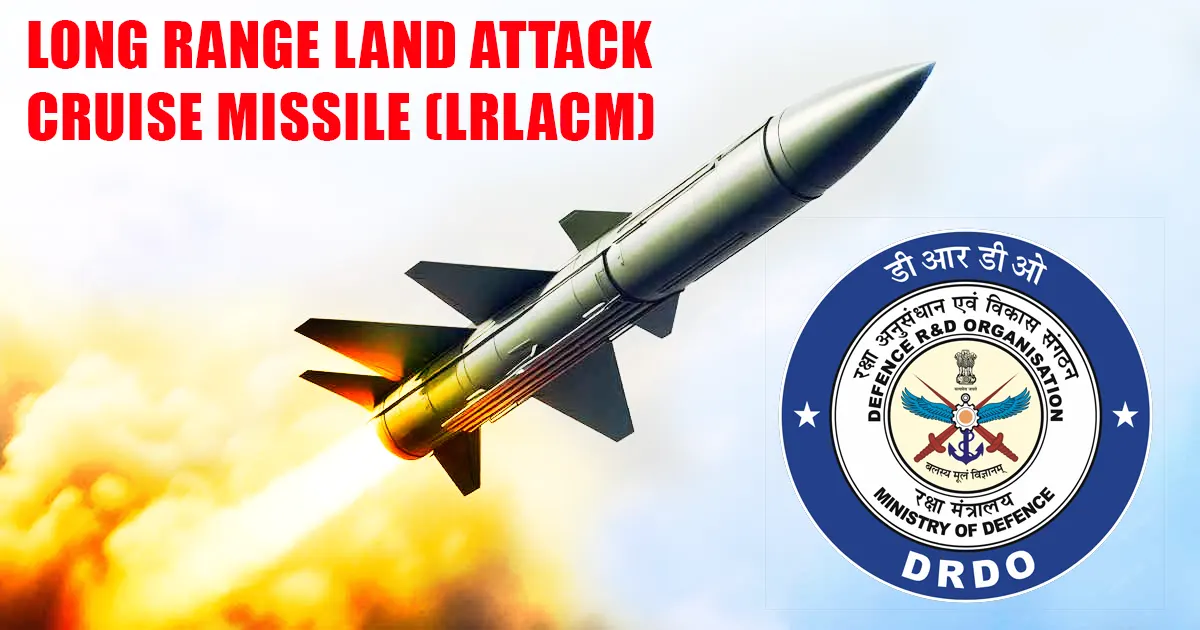
Context (PIB):
The Defence Research and Development Organisation (DRDO) successfully conducted the first flight test of the Long Range Land Attack Cruise Missile (LRLACM). This missile is part of a Defence Acquisition Council (DAC)-approved project and was developed under the Acceptance of Necessity (AoN) guidelines. The missile was designed and developed by the Aeronautical Development Establishment (ADE), Bengaluru, with collaboration from various DRDO laboratories and Indian industries.
Key Production Partners:
- Bharat Dynamics Limited (BDL)
- Bharat Electronics Limited (BEL)
These organizations have played a key role in the production of the missile, contributing to its successful development and testing.
About the Long Range Land Attack Cruise Missile (LRLACM)
The LRLACM is an advanced cruise missile designed for long-range precision strikes against land-based targets. It is equipped with a variety of features that enhance its versatility and effectiveness in combat scenarios.
Key Features and Capabilities:
- Range and Adaptability:
- The missile is capable of being launched from both mobile ground-based systems and frontline ships, providing operational flexibility in different environments and situations.
- Waypoint Navigation:
- The LRLACM uses waypoint navigation, which allows it to follow a pre-determined path while also having the ability to adjust its course mid-flight. This feature enables the missile to adapt to changing mission requirements and target conditions.
- Manoeuvrability:
- The missile has demonstrated impressive manoeuvrability, capable of performing complex maneuvers while maintaining stability across varying altitudes and speeds. This enhances its capability to evade countermeasures and engage targets with high precision.
- Advanced Avionics and Software:
- The LRLACM is equipped with sophisticated avionics and software, which significantly enhance its performance accuracy. These systems improve the missile’s reliability, ensuring precise targeting and engagement, even in challenging operational conditions.
Defence Acquisition Council (DAC)
The Defence Acquisition Council (DAC) is the highest decision-making body in the Indian Ministry of Defence. It plays a crucial role in approving new policies and capital acquisitions for the Indian military services: Army, Navy, Air Force, and the Indian Coast Guard.
Functions of the DAC:
- Approval of AoN (Acceptance of Necessity): The DAC gives the formal nod for specific equipment or systems, acknowledging their necessity for the Indian defence forces. The AoN is a critical step in the defence procurement process.
- Categorisation of Acquisition Proposals:
- ‘Buy’ Projects: Involves the direct purchase of equipment and systems.
- ‘Buy and Make’ Projects: Procurement followed by licensed production and indigenous development.
- ‘Make’ Projects: Focus on indigenous production and research & development (R&D).
The AoN approval from DAC allows the procurement process to move forward to the stages of tendering and acquisition, ensuring alignment with the strategic needs of the Indian Armed Forces.
Acceptance of Necessity (AoN)
- AoN is a formal step in the Indian defence procurement process. It signifies that a particular equipment or system is officially recognized as essential by the authorities. This approval allows the acquisition process to continue to the next stages, such as tendering, procurement, and manufacturing, ensuring that the acquisition is aligned with India’s defence strategy and needs.




